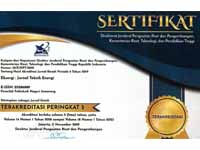Performance and Gas Emissions Analysis on Four Stroke Diesel Engine with Multi-Feedstock Biodiesel
DOI:
https://doi.org/10.32497/eksergi.v20i03.5864Keywords:
biodiesel, exhaust emissions, four stroke diesel engine, multi-feedstock, performanceAbstract
Biodiesel is one of the alternative fuels used in diesel engines. As the effectiveness of various biodiesel base materials varies, further studies on the effectiveness of biodiesel are needed. This study aims to evaluate the use of biodiesel from various sources as an alternative fuel. The methods in making multi-feedstock biodiesel are esterification and transesterification with palm oil, used cooking oil, and sunflower oil as raw materials. In this research, exhaust gas analysis and performance test on four stroke diesel engine were conducted. The mixture of biodiesel was then mixed with Pertamina Dex as High Speed Diesel (HSD) to produce B20, B35, and B100. The exhaust emission analysis focused on the concentration of (NOx) and (CO) gases at each rotation and load. The test result shows that B100 (100% multi-feedstock biodiesel) is the most optimal and environmentally friendly fuel with the same conditions of maximum load of 4000 watts and maximum rotation of 1400 rpm, NOx levels of 1396 mg/m3 and CO 474 ppm and has high power in all variations. On the other hand, HSD has the lowest gsfc in all variations.
References
Prasetyo, A.W. and Windarta, J. (2022) 'Utilization of Carbon Capture Storage (CCS) Technology to Support Sustainable Energy Production', Journal of New and Renewable Energy, 3(3), pp. 231-238.
Fahmi, I., Soelistyo, T., Maulani, M., Sasongko, N. A., & Yoesgiantoro, D. (2022). Biofuels as a substitute for fossil fuels (Biofuels: Biodiesel, Bioethanol, BioAvtur, Green Diesel, Green Gasoline, Green Avtur). Journal of Patriot Biru Quarterly, 1(3), 51-58.
A. Dahiya, Biofuels economics, sustainability, environment and policy, Second Edi. Elsevier, 2020. doi: 10.1016/B978-0-12-815497-7.02007-8.
Ministry of Energy and Mineral Resources, "Performance Achievement of the Energy and Mineral Resources Sector in 2021 and Plan for 2022," Ministry of Energy and Mineral Resources Website. ESDM, p. 43, 2022, [Online].
I. Nurhadi, "The Effect of Biodiesel Use on Performance and Main Components in the Main Motor of Kri Weling-822," Thesis-Me 14251, 2015.
A. Wijono, "Impact of vehicle emission reduction on the use of 20% biodiesel blend," J. Nas. Science and Technol. no. November, pp. 1-12, 2017.
Minister of Environment and Forestry of the Republic of Indonesia. (2021). Regulation of the Minister of Environment and Forestry of the Republic of Indonesia Number 11 of 2021 concerning Emission Quality Standards for Engines with Internal Combustion. Ministry of Environment, 1-32.
Rahmat, A. (2019). Dissecting Policies and Pluses and Minuses of Biodiesel Use in Indonesia. https://coaction.id/membedah-kebijakan-dan-plus-minus-penggunaan-biodiesel-di-indonesia/
EBTKE, H. (2021). Opportunities and Challenges of Utilizing Used Cooking Oil-Based Biodiesel. https://ebtke.esdm.go.id/post/2021/03/09/2824/peluang.dan.tantangan.pemanfaatan.biodiesel.berbasis.minyak.jelantah.
Utami, T. (2019). Biodiesel from Sunflower Seed Oil Utilization as an Alternative Energy to Replace Petroleum. https://iatekunsri.com/biodiesel-dari-pemanfaatan-minyak sunflower-seed-as-an-alternative-energy-to-replace-petroleum/#:~:text=Sunflower-seed-is-also-used-to-replace-petroleum.
Haryono, E., & Witjonarko, R. D. E. (2017). Performance Analysis of Two Stroke Marine Diesel Engine Fueled by a Mixture of Solar Oil (Hsd) and Used Cooking Oil Biodiesel at Full Load Simulator Load. Inovtek Polbeng, 7(2), 179-187. http://ejournal.polbeng.ac.id/index.php/IP/article/view/220
S. Semin, A. Iswantoro, and F. Faris, "Performance and NOx Investigation on Diesel Engine using Cold EGR Spiral Tube: A Review," 2017. doi: 10.12962/j25481479.v1i3.2372.
EBTKE. 2024. FAQ : Program Mandatori Biodiesel 30% (B30). https://ebtke.esdm.go.id/post/2019/12/19/2434/faq.program.mandatori.biodiesel.30.b30. Accessed on August 22, 2024.
Downloads
Published
Issue
Section
License
Copyright (c) 2024 Eksergi : Jurnal Teknik Energi

This work is licensed under a Creative Commons Attribution 4.0 International License.
Authors who publish with this journal agree to the following terms:Authors retain copyright and grant the journal right of first publication with the work simultaneously licensed under a Creative Commons Attribution License that allows others to share the work with an acknowledgement of the work's authorship and initial publication in this journal.
Authors are able to enter into separate, additional contractual arrangements for the non-exclusive distribution of the journal's published version of the work (e.g., post it to an institutional repository or publish it in a book), with an acknowledgement of its initial publication in this journal.
Authors are permitted and encouraged to post their work online (e.g., in institutional repositories or on their website) prior to and during the submission process, as it can lead to productive exchanges, as well as earlier and greater citation of published work (See The Effect of Open Access).






